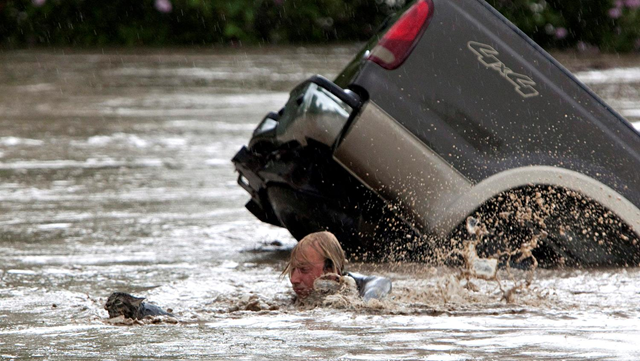3 dead in record Canada floods as water starts to recede
CALGARY, Alberta – The two rivers that converge on the western Canadian city of Calgary are receding Saturday after floods devastated much of southern Alberta province, causing at least three deaths and forcing thousands to evacuate. The flooding forced authorities to evacuate Calgary’s entire downtown and hit some of the city’s iconic structures hard. The Saddledome, home to the National Hockey League’s Calgary Flames, was flooded up to the 10th row, leaving the dressing rooms submerged. Flames’ president and CEO Ken King said Saturday that the Saddledome is a “real mess,” with water still up to row 8 of the lower bowl. He said the flooding has caused a total loss on the event level with all mechanical equipment submerged under 15 feet (4.5 meters) of water. “If you were a hockey player walking out of the tunnel to the ice, you’d be underwater yourself,” he said during a press conference. Water lapped at the roof of the chuckwagon barns at the grounds of the Calgary Stampede, which is scheduled to start in two weeks. Calgary Mayor Naheed Nenshi has said the city will do everything it can to make sure that the world-renowned party goes ahead. Bruce Burrell, director of the city’s emergency management agency, said Saturday they are seeing improvements in the rivers. Dan Limacher, director of water services for the city, said the Elbow river is expected to recede by about 60 percent over the next two days, while the larger Bow river will recede by about 25 percent. The improving conditions Saturday morning prompted Calgary’s mayor to tweet: “It’s morning in Calgary! Sunny, water levels are down, and our spirit remains strong. We’re not out of this, but maybe have turned corner.” However, Nenshi said later Saturday that while the city may have turned a corner, there is still a state of emergency in effect. “Flows on Elbow and Bow (rivers) are dropping slowly. We do believe the peak has passed on the Elbow. However, water levels are still four times higher than 2005 flood levels,” he said during a press conference. Overflowing rivers on Thursday and Friday washed out roads and bridges, soaked homes and turned streets into dirt-brown waterways around southern Alberta. High River, southwest of Calgary, was one of the hardest-hit areas and remained under a mandatory evacuation order. Police said they have recovered three bodies in the town. It is estimated that half the people in the town of 13,000 experienced flooding in their homes. Police cut off access to most of the town and helicopters circled overhead. Abandoned cars lay submerged in water, while backhoes worked in vain to push water back from houses. […] Alberta Premier Alison Redford has warned that communities downstream of Calgary have not yet felt the full force of the floodwaters. Medicine Hat, downstream from Calgary, was under a mandatory evacuation order affecting 10,000 residents. [more]
3 dead in Canada floods as water starts to recede 
EDMONTON, 21 Jun 2013 (The Canadian Press) – Alberta’s floods are already breaking records that were set less than 10 years ago. University of Alberta hydrologist Uldis (OOL’-diss) Silins (SIH’-lins) says flow levels in southern Alberta rivers submerged all records by a wide margin Thursday. He says the Elbow River near Bragg Creek was 66 per cent higher than it was in the 2005 flood, which was considered a 100-year event in many places in that watershed. Silins says the torrents are the result of a weather system that’s moving slowly, covering a wide area and releasing an unusually large amount of rain — up to 180 millimetres over 16 hours in some areas. That’s so much rain that soils on the eastern slopes of the Rockies can’t soak it up. Silins says large areas that usually absorb water are now adding to the runoff.
Alberta flood levels wash away record from 100-year event 8 years ago
